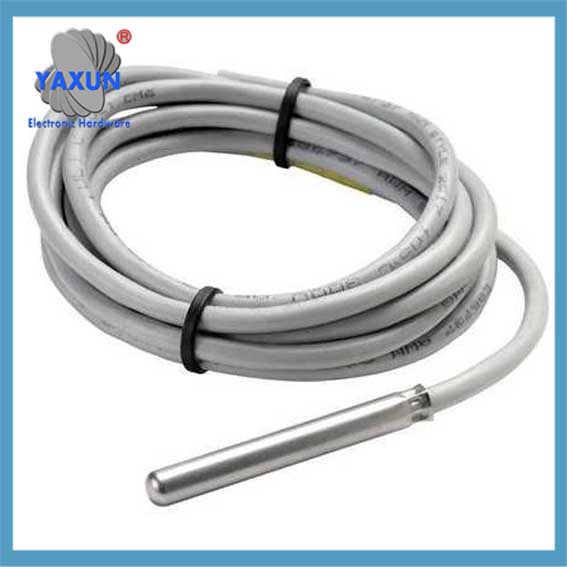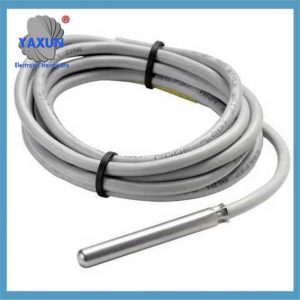製品カテゴリ
- 温度ヒューズ 32
- 表面実装ヒューズ 12
- サーミスター 36
- PCB マウント ヒューズ ホルダー 27
- ワイヤハーネス 6
- ブレードヒューズホルダー 17
- サーモスタット 50
- 電気ヒューズ 24
- 自動車温度センサー 7
- サーマルサーキットブレーカー 22
- ヒューズボックスホルダー 36
- 温度センサー 75
- サーマルスイッチ 68
- カーヒューズ 20
- ボルトダウンヒューズ 8
製品タグ
NTC, PTC, PT100, DS18B20 温度プローブセンサー用
熱電対プローブ: 熱電効果を利用して温度を測定します, 広い測定範囲と速い応答速度が特徴です。.
熱抵抗プローブ: 金属や半導体材料の抵抗が温度とともに変化する性質を利用して温度を測定する, 測定精度が高く、安定性が良いという特徴があります。.
半導体プローブ: 半導体材料の導電率が温度によって変化するという特性を利用して温度を測定します, サイズが小さいのが特徴です, 軽量かつ低消費電力.
NTC, PTC, PT100, DS18B20 Temperature probes and temperature sensors play an important role in the field of temperature measurement. The following is a detailed introduction to temperature probe sensors:
There are many types of temperature sensors, 含む:
Thermocouples
These sensors are made of two dissimilar metals that connect at two points to form a junction. They are reliable, accurate, and can operate over a wide range of temperatures.
抵抗温度検出器 (RTD)
These sensors are based on the change in resistance of a metal as the temperature changes.
サーミスタ
These sensors use the temperature characteristics of semiconductor resistors, which change resistance as the temperature changes. Thermistors are sensitive and have high accuracy relative to their cost.
負の温度係数 (NTC) サーミスタ
These sensors are sensitive and can respond to very small temperature changes. They have a temperature range of -50 °Cに 250 ℃.
Resistive temperature detectors
These sensors have positive temperature coefficients (PTC) and offer precise temperature measurements. しかし, they have poor sensitivity.
1. Definition and working principle
Temperature probe:
意味: A temperature probe is a device specifically used to measure temperature, and its core component is a temperature-sensitive element.
動作原理: A temperature probe uses sensitive elements (such as thermocouples, thermal resistors, semiconductors, 等) to convert temperature changes into electrical signals for subsequent circuit processing or display.
Temperature sensor:
意味: A temperature sensor is a broader concept that includes a temperature probe and a signal processing circuit connected to it.
動作原理: A temperature sensor not only includes a sensitive element, but also has a signal processing circuit that can complete the acquisition, processing and output of temperature signals, usually in the form of digital or analog signals.
2. Types and characteristics
Temperature probe type:
熱電対プローブ: 熱電効果を利用して温度を測定します, 広い測定範囲と速い応答速度が特徴です。.
熱抵抗プローブ: 金属や半導体材料の抵抗が温度とともに変化する性質を利用して温度を測定する, 測定精度が高く、安定性が良いという特徴があります。.
半導体プローブ: 半導体材料の導電率が温度によって変化するという特性を利用して温度を測定します, サイズが小さいのが特徴です, 軽量かつ低消費電力.
Temperature sensor type:
Analog temperature sensor: outputs analog signals, which need to be converted into digital signals by analog-to-digital converters for subsequent processing.
Digital temperature sensor: directly outputs digital signals, 強い干渉能力があります, 高い正確性, and is easy to integrate into the control system.
Intelligent temperature sensor: has self-diagnosis, self-calibration, communication and other functions, and can realize remote monitoring and control.
3. Selection and application
選択要素:
Application environment: Consider whether the measured environment has special conditions such as corrosiveness, high temperature, 高圧, 等, so as to select suitable materials and protection levels.
測定範囲: Select a suitable sensor according to the range of the temperature to be measured to ensure that the sensor can accurately measure within the required range.
精度要件: According to the accuracy requirements of the application for temperature measurement, select a sensor with corresponding accuracy.
Cost budget: Under the premise of ensuring performance, consider cost factors and choose cost-effective sensors.
Application areas:
産業オートメーション: used to monitor temperature changes in industrial equipment, machines and production processes to ensure normal operation of equipment and product quality.
Medical industry: used in medical equipment, temperature monitoring instruments and drug storage equipment to monitor patient temperature, ambient temperature and drug storage conditions.
自動車産業: used in electric vehicle motors, capacitors, DC converters, charging systems, as well as automobile engines, gearboxes, air conditioning systems and exhaust systems to monitor and control the temperature of various liquids and gases.
Agriculture and food processing industry: used in agricultural greenhouses, cold storage, food processing equipment and transport vehicles to monitor and control the temperature of agricultural products and food.
Other fields: such as air conditioning and refrigeration industry, military and aerospace industry, Internet of Things industry, 等. are also widely used.
IV. 使用とメンテナンス
Installation: Install the sensor correctly according to the installation instructions to ensure good contact between the sensor and the object to be measured and avoid measurement errors caused by improper installation.
Wiring: Correctly connect the signal line and power line of the sensor to ensure the stability and accuracy of signal transmission.
Calibration: Calibrate the sensor regularly to ensure that its measurement accuracy meets the application requirements. The calibration process usually involves placing the sensor in a known temperature environment, comparing the difference between its output value and the standard value, and making necessary adjustments.
Maintenance: Clean and maintain the sensor regularly to avoid dust, dirt, 等. that affect the measurement performance of the sensor. 同時に, pay attention to check whether the cable connection is loose or damaged, and replace damaged parts in time.
要約すれば, temperature probe sensors have a wide range of applications and an important position in the field of temperature measurement. When selecting and using them, it is necessary to make comprehensive considerations based on the specific application scenarios and requirements to ensure the accuracy and reliability of the measurement results. If you have any other questions or need further help, please feel free to let me know.
お問い合わせ
メールを待っています, 以内に返信させていただきます 12 必要な貴重な情報を何時間も入手できる.
 English
English Afrikaans
Afrikaans العربية
العربية বাংলা
বাংলা bosanski jezik
bosanski jezik Български
Български Català
Català 粤语
粤语 中文(简体)
中文(简体) 中文(漢字)
中文(漢字) Hrvatski
Hrvatski Čeština
Čeština Nederlands
Nederlands Eesti keel
Eesti keel Suomi
Suomi Français
Français Deutsch
Deutsch Ελληνικά
Ελληνικά हिन्दी; हिंदी
हिन्दी; हिंदी Magyar
Magyar Bahasa Indonesia
Bahasa Indonesia Italiano
Italiano 日本語
日本語 한국어
한국어 Latviešu valoda
Latviešu valoda Lietuvių kalba
Lietuvių kalba македонски јазик
македонски јазик Bahasa Melayu
Bahasa Melayu Norsk
Norsk پارسی
پارسی Polski
Polski Português
Português Română
Română Русский
Русский Cрпски језик
Cрпски језик Slovenčina
Slovenčina Slovenščina
Slovenščina Español
Español Svenska
Svenska ภาษาไทย
ภาษาไทย Türkçe
Türkçe Українська
Українська اردو
اردو Tiếng Việt
Tiếng Việt












